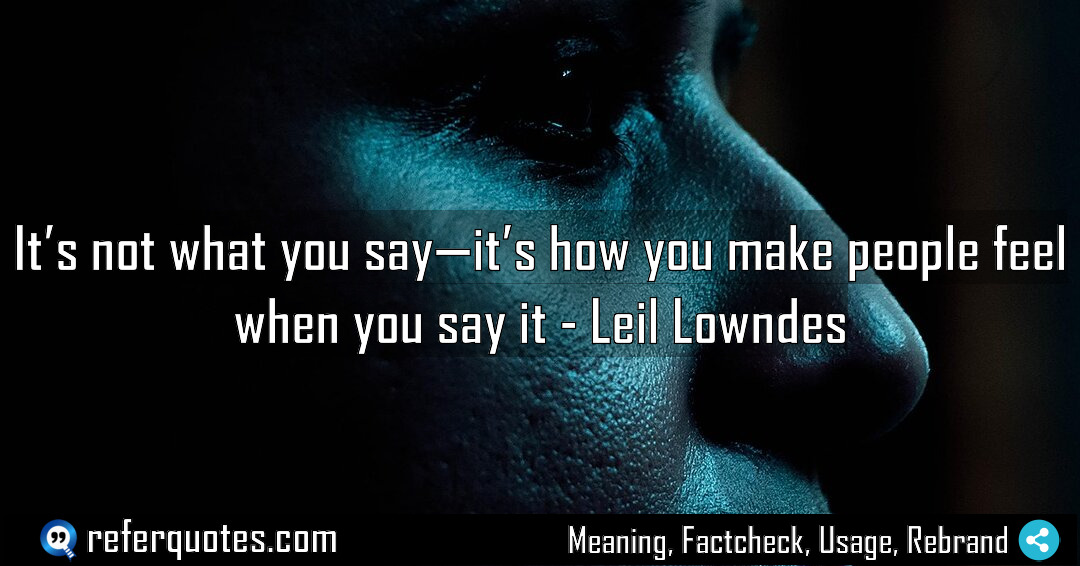
You know, it’s not what you say—it’s how you make people feel. That’s the real secret to building genuine connections, whether you’re leading a team, closing a deal, or just trying to be a better friend. The words are just the vehicle; the emotional residue is what truly lasts and defines your relationships.
Share Image Quote:
Table of Contents
Meaning
The core message is that the emotional impact of your communication far outweighs the literal meaning of your words.
Explanation
Let me break this down for you. I’ve seen this principle play out a thousand times in boardrooms and coffee shops. You can have the most brilliant idea, the most logical argument, but if you deliver it in a way that makes the other person feel stupid, or small, or ignored, you’ve lost. They’ll shut down. The content becomes irrelevant. Your tone, your body language, the simple act of making full eye contact—that’s the stuff that builds trust and rapport. It’s the difference between being heard and being felt.
Quote Summary
Reading Level68
Aesthetic Score92
Origin & Factcheck
This gem comes straight from Leil Lowndes’s 1999 book, How to Talk to Anyone. You’ll sometimes see this sentiment, or something very close to it, mistakenly attributed to Maya Angelou, who famously talked about people forgetting what you said but remembering how you made them feel. The core idea is similar, but this specific phrasing is Lowndes’s.
Attribution Summary
Author Bio
Leil Lowndes writes about striking conversations with unknown people and how to put others at ease and maintain relationships. Her techniques are straightforward and practically usable that readers can apply immediately in their workplace, and everyday life. Her book list includes How to Talk to Anyone and Goodbye to Shy which have reached international audiences.
Official Website |Facebook | X | YouTube |
Where is this quotation located?
| Quotation | It’s not what you say—it’s how you make people feel when you say it |
| Book Details | Publication Year: 1999; ISBN: 978-0-07-141858-4; Last edition: 2018; Number of pages: 368. |
| Where is it? | Chapter 64: The Emotional Impact, Approximate page 249 from 2018 edition |
Context
Lowndes’s entire book is a practical guide, a toolkit. This quote isn’t just philosophical fluff; it’s the foundational principle for all 92 of her “little tricks.” Everything from her advice on a “sticky eyes” to a “parrot” technique is designed to execute on this single, powerful idea: engineer a positive feeling in the other person.
Usage Examples
So, how do you actually use this? It’s simpler than you think.
For a Manager giving critical feedback: Don’t just blast an email listing failures. Have a conversation. Start with what they’re doing right. Make them feel like you’re on their team, invested in their growth, not just their output. The feedback will land a hundred times better.
For a Salesperson: Stop feature-dumping. Listen more than you talk. Understand the client’s real problems and anxieties. Make them feel understood, and you become a trusted advisor, not just a vendor.
For Anyone in a Relationship: Your partner had a tough day. You can offer a logical solution, or you can just listen and say, “That sounds incredibly frustrating. I’m sorry you went through that.” One approach solves a problem; the other supports a person. Guess which one strengthens the bond?
To whom it appeals?
Share This Quote Image & Motivate
Motivation Score87
Popularity Score93
Shareability Score92
FAQ
Question: Does this mean the content of what I say doesn’t matter at all?
Answer: Not at all. The content is the “what,” but the delivery is the “how.” You need both. But perfect content with a terrible delivery will almost always fail, whereas decent content with an exceptional, empathetic delivery often succeeds brilliantly.
Question: How can I get better at this?
Answer: Practice active listening. Seriously. Put your phone away. Make eye contact. Focus on understanding the emotion behind someone’s words before you formulate your response. It’s a muscle you have to build.
Question: Is this being manipulative?
Answer: Only if your intent is selfish. If your genuine intent is to connect, to understand, and to build a positive interaction, then it’s not manipulation. It’s emotional intelligence. It’s being a more effective and caring communicator.
Similar Quotes
You know, when you really think about it, “People don’t remember what you said…” is the absolute key to connection. It’s not about your perfectly crafted words; it’s about the…
Communication is not what you say, it’s what the listener understands. This simple shift in perspective completely reframes success in leadership and collaboration. It moves the responsibility from the speaker…
You know, that old saying, “People will forget what you said, they will forget what you did…” really nails it. It’s all about the emotional residue you leave behind. The…
You know, I’ve seen it a million times. People are not influenced by what we say… it’s a game-changer. It forces you to stop talking and start thinking about the…
You know, I’ve seen it time and again: People rarely remember what you said, but they never forget the feeling you gave them. It’s the secret sauce in every successful…
